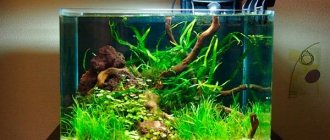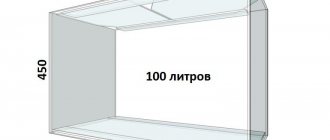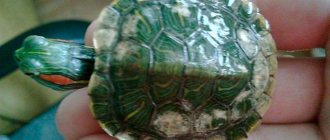Red-eared turtles can live up to 30 years in good conditions. Many owners, with an inept approach, shorten their life to 3-5 years. Some people believe that to keep a turtle at home, it will be enough to put a basin of water and a pebble in it. However, turtles are demanding animals and for their normal development you will need to purchase an aquaterrarium, build or buy a resting island, a UV lamp and a heating lamp, a thermometer and a water filter.
Aquaterrarium
A low but wide aquaterrarium, the volume of which is designed for 120-150 liters of water, is suitable for keeping the red-eared turtle. Many people think that a small turtle will simply get lost in such an aquarium. But she is growing and will need space to float and roll over freely.
In addition to water, the turtle needs an island, with a comfortable and non-slippery rise, so that the turtle can easily crawl onto land and warm itself. Islands can be bought in specialized stores or made with your own hands. You can put driftwood or a stone with a rough surface. But store-bought islands, unlike those made at home, are more stable and have a textured surface. Another factor determining the quality of the island is the absence of piercing burrs and sharp corners.
Soil and plants
Depending on the purpose for which the turtle was purchased: as a pet or for breeding for sale, the soil is selected. In the first case, the bottom of the aquarium can be decorated with large stones, since turtles can swallow gravel. When breeding, you will need shallow soil so that the turtle can freely dig through it and lay eggs. You can add a layer of washed river sand.
Aquarium plants are of interest to the turtle; she tries to taste each of them, and if she likes it, the plant will be eaten; if she doesn’t like it, she will pull it out by the roots. Therefore, it is recommended to “plant” artificial plants in aquariums.
Thermal mats and thermal cords
A built-in reptile heater is the safest way to maintain the desired temperature. Heating mats and cords are available for sale to create a comfortable temperature regime.
- The cords are laid on the bottom of the terrarium and ensure uniform heating of the entire area. They differ in their length and power.
- If the pet prefers to spend most of its time on the floor of the terrarium, rugs are placed under the bottom. They evenly heat the substrate poured onto the floor of the terrarium, imitating hot desert sand or well-heated stones in the jungle. For pets who like to climb trees and other decorative elements, choose rugs with side wall mounts.
The 12 Monkeys online store offers a full range of heating devices and equipment for terrariums. If you are wondering where to buy a turtle warmer, just contact us! You can not only make profitable purchases, but also receive qualified consulting assistance.
Coast heating and temperature maintenance
Turtles are heat-loving animals and, living in natural conditions, they love to bask in the sun. To bring the maintenance at home closer to natural conditions, you will need to install a heating lamp. To maintain optimal temperature in the aquarium there must be a thermometer.
When placing the lamp, you should pay attention to two things: firstly, it should not be located too low above the island, and secondly, you will have to install protective glass between the lamp and the water so that splashes of water do not fall on the hot lamp.
The operating time of the heating lamp is 10-12 hours a day. You can purchase it in a specialized store.
Other turtle aquarium equipment
Heater
The average water temperature in the aquarium is 21-24 C (21 in winter, 24 in summer, respectively).
For different species it may be a little more or less. For example, for swamp turtles the temperature should be lower than for red-eared turtles. The easiest way to maintain a constant temperature in your aquarium is to use a heater that is immersed in water. There are two types of aquarium heaters: glass and plastic. A plastic heater is better than a glass one because turtles cannot break it and cannot get burned on it.
A glass water heater resembles a long glass tube. These types of heaters are very practical because they are already sold with a built-in thermostat that allows you to maintain the temperature at the same level. The heater is selected at the rate of 1L = 1 W. The temperature is set as required for this type of turtle. It is best to buy a rigid and unbreakable horizontal type water heater with good suction cups. Some aquatic turtles tear the heaters off their suction cups and chase them around the entire aquarium. To prevent turtles from moving the aquarium heater, it must be covered with large stones. For large and aggressive turtles (vulture, snapping), the water heater should be separated by a wall. To control the temperature, you can hang a thermal sticker on the outer water part of the aquarium.
Water heaters are sold in all pet stores with an aquarium department.
Mineral block neutralizer (turtle tank neutralizer)
Neutralizes the acidity of aquarium water, promotes its purification and enriches it with calcium. The water neutralizer block is used to purify water and also as a source of calcium when aquatic turtles nibble on it. Its necessity for turtles has not yet been proven. Cuttlefish bone and other reptile calcium mineral blocks without vitamins or other supplements are also suitable.
Siphon, hose bucket
Necessary for changing water. Despite the presence of a filter, the water still needs to be changed at least once every 1-2 months. It is convenient to use a hose with a pump that pumps out the water itself, but if this is not the case, then you can proceed as follows:
a certain amount of water is poured into the bucket; The hose is filled to the brim with water. Next, one end of the hose with water is placed in a bucket, the other in the turtle’s aquarium. Water from the hose will flow into the bucket, carrying water from the aquarium with it, so the water will overflow on its own.
Tools for measuring and changing the pH of water
(This is important for some exotic turtle species) pH meters and pH increasers or decreasers can be used. Sera pH-Test or Sera pH-meter - for monitoring pH levels. Sera pH-minus and Sera pH-plus - to increase or decrease the pH level. Sera aqatan is used for water treatment. It binds harmful metal ions and protects against aggressive chlorine.
conditioner is suitable for softening and preparing tap water . It neutralizes chlorine and heavy metals, and the colloids will protect the turtles' skin and reduce the risk of skin diseases.
Aeration means
Desirable for Trionics, but not needed (although they do not harm) other turtles. Aeration agents saturate the water with oxygen, forming bubbles. Aerators are sold as separate devices or built into a filter (in this case, the air intake tube must lead from the water to the surface).
Aeration means are desirable for Trionics, but are not necessary (although they do not harm) other turtles.
Time relay or timer
The timer is used to automatically turn on and off lights and other electrical appliances. This device is not necessary, but is advisable if you want to train turtles to a certain routine. The duration of daylight hours should be 10-12 hours. Time relays are electromechanical and electronic (more complex and expensive. Relays also come in seconds, minutes, 15 and 30 minutes. Time relays can be bought in terrarium stores and electrical goods stores (household relays), for example, in Leroy Merlin or Auchan.
Voltage stabilizer or UPS
A voltage stabilizer or UPS is needed if the voltage in your home fluctuates, there are problems at the substation, or for a number of other reasons that affect electricity, which can lead to the burning of ultraviolet lamps and aquarium filters. Such a device stabilizes the voltage, smoothes out sudden surges and brings its performance to acceptable values. More details in a separate article on turtles.info.
Tweezers
Quite necessary devices can be tweezers and forceps (tongs for grasping food). They are needed for hand-feeding turtles with any food, including small mice, which are convenient to hold with forceps.
Turtle brush
Many turtles love to scratch their shell, so you can attach a scratching brush to the aquarium to provide them with this opportunity.
UV sterilizer
This is a device that serves to disinfect water from bacteria, fungi, viruses, algae and protozoan microorganisms, many of which are pathogenic and pose a direct threat to the health and life of aquatic inhabitants. By treating water with hard ultraviolet irradiation with a wavelength of 250 nm, it allows you to control the number of pathogens of many diseases of aquarium and pond fish. The principle of operation of the UV is as follows: water from the aquarium, under pressure created by the pump, passes through the filter and is supplied to the sterilizer, which is usually located outside the aquarium (in a cabinet, on a shelf above or below the aquarium). Inside the sterilizer, the water is treated with an ultraviolet lamp, and, coming out from the opposite side of the water intake, it again enters the aquarium. This cycle occurs constantly.
Since the sterilizer does not directly affect animals, it will not harm fish or turtles, but it can destroy green algae (green euglena). Long-term (more correctly, unreasonable or unbalanced) use of a UV sterilizer can cause an outbreak of blue-green algae! Therefore, if you think that you cannot do without a UV sterilizer, then buy it.
UV lamp
Depending on the age of the turtles, the power of the UV lamp is selected:
- for young individuals – 5% UVB;
- for adults – 10% UVB.
The presence of an ultraviolet lamp is the main condition for the normal development of red-eared turtles. To prevent animals from getting eye burns, the UV lamp should be installed at a level of at least 25 cm and turned on for 10-12 hours, turned off only at night.
Ultraviolet radiation prevents the development of rickets, improves metabolism, and affects the activity of turtles. The rays help absorb calcium, which is necessary for building the shell.
Water
To successfully keep a red-eared turtle, the water temperature should not fall below +20 ºC, the most optimal parameter is +22+28 ºC.
The turtle spends almost all its time in water, so care should be taken to ensure that the water is clean. Animals sleep, eat and defecate directly in the water, so it needs to be changed frequently. A filter must be installed in the aquarium.
In a dirty aquatic environment, pathogenic microorganisms develop that cause various infectious diseases of turtles, which are then difficult to cure.
The water level in the aquaterrarium should be higher than the size of the turtle's shell. This is done so that an animal that accidentally ends up on its back can easily roll over on its own.
Normal development of red-eared turtles is possible only if good conditions are created for them. The turtle becomes a beloved pet, so you need to take care of it accordingly.
Water and land in an aquaterrarium
Divide the entire space at the bottom into approximately three parts. Two should be on the water, and at least 20 cm should remain to the edge. The remaining third is dry land, where the turtle will bask and rest. Create an island-zone for her so that she does not have to climb too high and so that the reptile does not slide. As an option, they install a flat staircase with wide steps or a small improvised ladder. A large flat stone that is securely fixed to the bottom is suitable as an island - the turtle should not be able to turn it over. Do not place the stone too close to the wall of the aquarium and do not place it too high. Otherwise, the turtle may get out.
If the size of the aquaterrarium allows, then make two islands of different heights. Place one under the lamp, the second in the shade. If you have two turtles, then each should have its own sitting area.
At the bottom of the aquaterrarium, place soil - for example, pebbles with particles of at least 5 cm or just large stones. Pebbles and glass balls that are too small are not suitable, as large reptiles run the risk of swallowing them with negative consequences for the gastrointestinal tract. Sand or peat are also not suitable - they are uncomfortable for the turtle and difficult to wash. You can buy large artificial granules or calcined mineral blocks at the pet store - this is the best alternative to large pebbles.
Vegetation in an aquaterrarium with a red-eared turtle is completely optional. You can place something for beauty, but in the end your pet will simply chew it. For decoration, place a variety of driftwood, previously cleared of bark. Plastic vines and algae are suitable.
Take care of the cleanliness of the water in the aquaterrarium. It is extremely important for a turtle to be in clean water, which it quickly pollutes. Special filters will help maintain the cleanliness and transparency of the water environment. It is better to choose an external one, since the internal one is more of a hassle and will quickly become unusable. If you have a good filter, complete water changes can be done much less frequently. It is enough to fill it once a week with fresh water, pre-settled at room temperature for 24 hours - about half the volume.











